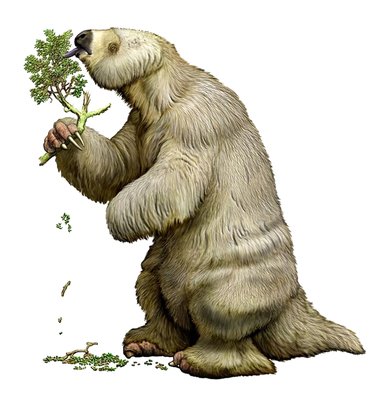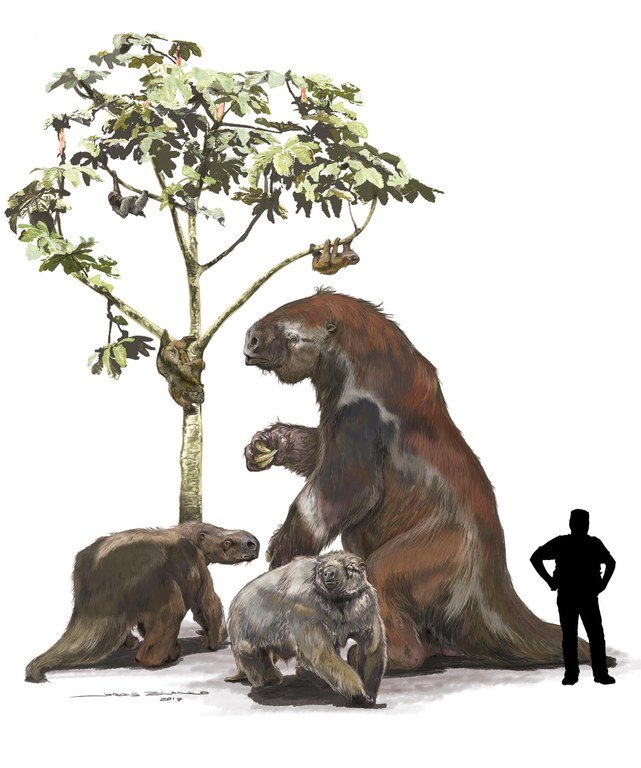Ancient DNA suggests drastically different evolutionary history for modern and extinct sloths
New mitochondrial genomes for extinct sloths suggests a very different evolutionary path for giant ground and Caribbean sloths.
Jun 06, 2019
 Two papers published today in Current Biology and Nature Ecology and Evolution examining ancient DNA and proteins has completely reshuffled the sloth evolutionary tree. An international collaboration involving scientists from the McMaster Ancient DNA Centre has generated 10 new mitochondrial genomes from 6 extinct sloth species five of which are represented for the first time at the complete mitochondrial level. Species analyzed include two deeply divergent Caribbean sloths which possibly migrated to the Great Antilles 30-35 million from South America via the GAARlandia land‐bridge. This paper also presents the first complete mitochondrial genomes from Megatherium americanum, the largest ground sloth to ever live. Both the genetic and proteomic data suggest that currently accept morphology-based evolutionary relationships among living and extinct sloth species need to be reevaluated in light of new palaeomolecular data, and represent the next step in solving the centuries old puzzle of Xenarthran evolution.
Two papers published today in Current Biology and Nature Ecology and Evolution examining ancient DNA and proteins has completely reshuffled the sloth evolutionary tree. An international collaboration involving scientists from the McMaster Ancient DNA Centre has generated 10 new mitochondrial genomes from 6 extinct sloth species five of which are represented for the first time at the complete mitochondrial level. Species analyzed include two deeply divergent Caribbean sloths which possibly migrated to the Great Antilles 30-35 million from South America via the GAARlandia land‐bridge. This paper also presents the first complete mitochondrial genomes from Megatherium americanum, the largest ground sloth to ever live. Both the genetic and proteomic data suggest that currently accept morphology-based evolutionary relationships among living and extinct sloth species need to be reevaluated in light of new palaeomolecular data, and represent the next step in solving the centuries old puzzle of Xenarthran evolution.
Ancient Mitogenomes Shed Light on the Evolutionary History and Biogeography of Sloths
Authors: Frédéric Delsuc, Melanie Kuch, Gillian C. Gibb, Emil Karpinski, Dirk Hackenberger, Paul Szpak, Jorge G. Martínez, James I. Mead, H. Gregory McDonald, Ross D. E. MacPhee, Guillaume Billet, Lionel Hautier, and Hendrik N. Poinar
Current Biology, Vol 29. June 2019. DOI: https://doi.org/10.1016/j.cub.2019.05.043
Abstract
Living sloths represent two distinct lineages of small-sized mammals that independently evolved arboreality from terrestrial ancestors. The six extant species are the survivors of an evolutionary radiation marked by the extinction of large terrestrial forms at the end of the Quaternary. Until now sloth evolutionary history has mainly been reconstructed from phylogenetic analyses of morphological characters. Here we used ancient DNA methods to successfully sequence 10 extinct sloth mitogenomes encompassing all major lineages. This includes the iconic continental ground sloths Megatherium, Megalonyx, Mylodon, and Nothrotheriops, and the smaller endemic Caribbean sloths Parocnus and Acratocnus. Phylogenetic analyses identify eight distinct lineages grouped in three well-supported clades and whose interrelationships are markedly incongruent with the currently accepted morphological topology. We show that recently extinct Caribbean sloths have a single origin but comprise two highly divergent lineages that are not directly related to living two-fingered sloths, which instead group with Mylodon. Moreover, living three-fingered sloths do not represent the sister-group to all other sloths but are nested within a clade of extinct ground sloths including Megatherium, Megalonyx, and Nothrotheriops. Molecular dating also reveals that the eight newly recognized sloth families all originated between 36 and 28 million years ago (Mya). The early divergence of recently extinct Caribbean sloths around 35 Mya is consistent with the debated GAARlandia hypothesis postulating the existence at that time of a biogeographic connection between northern South America and the Greater Antilles. This new molecular phylogeny has major implications for reinterpreting sloth morphological evolution, biogeography, and diversification history.
Palaeoproteomics resolves sloth relationships - Nature Ecology and Evolution
